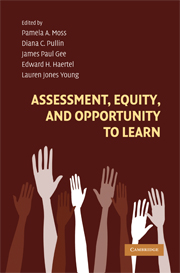Book contents
- Frontmatter
- Contents
- Preface
- List of Contributors
- ASSESSMENT, EQUITY, AND OPPORTUNITY TO LEARN
- 1 Introduction
- 2 Assessment Through the Lens of “Opportunity to Learn”
- 3 A Sociological Perspective on Opportunity to Learn and Assessment
- 4 A Sociocultural Perspective on Opportunity to Learn
- 5 Individualizing Assessment and Opportunity to Learn
- 6 Cultural Modeling as Opportunity to Learn
- 7 Opportunities to Learn in Practice and Identity
- 8 Game-Like Learning
- 9 Sociocultural Implications for Assessment I
- 10 Issues of Structure and Issues of Scale in Assessment from a Situative/Sociocultural Perspective
- 11 Sociocultural Implications for Assessment II
- 12 Assessment, Equity, and Opportunity to Learn
- Index
- References
5 - Individualizing Assessment and Opportunity to Learn
Lessons from the Education of Students with Disabilities
Published online by Cambridge University Press: 05 June 2012
- Frontmatter
- Contents
- Preface
- List of Contributors
- ASSESSMENT, EQUITY, AND OPPORTUNITY TO LEARN
- 1 Introduction
- 2 Assessment Through the Lens of “Opportunity to Learn”
- 3 A Sociological Perspective on Opportunity to Learn and Assessment
- 4 A Sociocultural Perspective on Opportunity to Learn
- 5 Individualizing Assessment and Opportunity to Learn
- 6 Cultural Modeling as Opportunity to Learn
- 7 Opportunities to Learn in Practice and Identity
- 8 Game-Like Learning
- 9 Sociocultural Implications for Assessment I
- 10 Issues of Structure and Issues of Scale in Assessment from a Situative/Sociocultural Perspective
- 11 Sociocultural Implications for Assessment II
- 12 Assessment, Equity, and Opportunity to Learn
- Index
- References
Summary
Students with disabilities are a group for whom opportunity to learn (OTL) and educational assessment present special issues of public policy and challenges for educational research and practice. These challenges highlight both the powerful prospects for improving schools and the significant limitations inherent in current practice. One commentator has suggested that “when read critically, special education provides the structural and cultural insights that are necessary to begin reconstructing public education for the historical conditions of the twenty-first century and, ultimately, for reconciling it with its democratic ideals” (Skrtic 1991, 206).
Children with disabilities were a group long excluded from our nation's schools. In 1974, Congress estimated that more than a million children with disabilities were not in school (Hehir and Gamm 1999; Pullin 1999). When a commitment was made to educate this population, it was embedded in a series of state and federal legal protections that define access to educational opportunity in a manner quite different from the opportunities afforded to students without disabilities. Although our system of educating students with disabilities is far from perfect in either design or implementation, examination of the treatment of students with disabilities affords a different lens for viewing the challenges associated with providing every child with a full and fair opportunity to learn utilizing appropriate and meaningful testing and assessment.
Almost nine percent of the students in the country, more than six million children and youth, received special education services in 2002 under the federal Individuals with Disabilities Education Act (IDEA); almost half of these students were those placed in the category of individuals with specific learning disabilities (U.S. Department of Education 2004).
- Type
- Chapter
- Information
- Assessment, Equity, and Opportunity to Learn , pp. 109 - 135Publisher: Cambridge University PressPrint publication year: 2008
References
- 4
- Cited by

